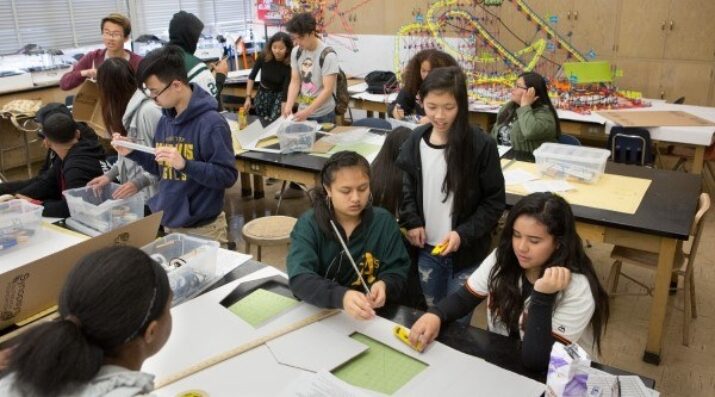The Power of Controlled Chaos: Fostering Engagement Through Learner Autonomy
Topics

We’ve all had the experience of truly purposeful, authentic learning and know how valuable it is. Educators are taking the best of what we know about learning, student support, effective instruction, and interpersonal skill-building to completely reimagine schools so that students experience that kind of purposeful learning all day, every day.
And how you as a teacher can deliver truly meaningful learning experiences.
Many educators feel hesitant to adopt student-centered teaching practices—like the Modern Classroom model—because they worry that, without a teacher at the front of the room, their classrooms will become chaotic. The most meaningful learning experiences, however, are usually chaotic! It’s student control of learning, rather than teacher control of instruction, that creates lasting knowledge and skills. In this article, I’ll explain why that is—and why, to stimulate true learning, educators must learn to embrace a bit of chaos.
***************
What were your most impactful learning experiences?
I was fortunate to have amazing teachers throughout my educational career, and as an educator myself I’ve often reflected on the lessons that really stuck. I want to share a few of those lessons—and I want you to see if you can detect a theme.
- In Mr. Seechin’s statistics class, I tried to figure out how airlines determine how many tickets to sell.
- In Ms. Nields’s U.S. History Class, I presented a case for why George Washington should have been impeached.
- In Ms. Parker’s science class, I built a machine to get a chicken over a fence (inspired by the movie Chicken Run).
- In Ms. Schnog’s English class, I wrote a short story inspired by my favorite song.
- In Señor Thomas’s Spanish class, each Monday I explained (in Spanish) what I’d done over the weekend.
What’s the theme here? All of these learning experiences were things that I, Rob, did! That’s why they’ve stuck with me—and why I can remember so clearly the content and skills that each of these experiences was meant to instill. I’m sure I spent a lot of time sitting at my desk and listening to these teachers talk, too… but I don’t remember any of that. What I remember is what these teachers had me do. And I’d guess that the great learning experiences you remember are similar, too.
What does that mean for us as educators? I think it means that what we say to our learners ultimately matters little—and that what we ask our learners to do—and then support in doing—matters a great deal. The lesson I take from this reflection is that, if we really want our students to learn, we as educators need to step back and let our students take control of their own learning.
Learning anything worth learning is hard, and messy, and generates mistakes and questions and sometimes even the need to blow off steam.
This is easier said than done. As a teacher I was trained in classroom management and taught that a well-run class was one in which students followed my lead. “Run your classroom,” I was told, and this is what I tried to do. I began to equate a well-run classroom with quiet, compliant students. I was in charge and I intended to keep it that way.
But here’s the problem. Learning isn’t quiet! And we rarely learn simply by following directions. Learning anything worth learning is hard, and messy, and generates mistakes and questions and sometimes even the need to blow off steam. I couldn’t have had each of the deep learning experiences I’ve described above just by sitting and listening. I needed to discuss, and move around, and ask my classmates and teachers for help. I needed a bit of freedom, and my classmates did too.
I realized eventually, in my own classroom, that if I wanted my students to really learn, they needed the same level of ownership. I also realized that this might cause chaos—students having multiple conversations about multiple topics, students moving around the room, students asking me different questions all at once.
I was nervous to release control, and at first, rightly so. There was a lot of activity going on, and not all of it productive: while some learners took to their newfound independence right away, others weren’t sure what to do. They liked freedom, but needed structure. Otherwise, they could spend time off track, or unsure where to go next. Some days I worried that my colleague next door, or even my principal, would come in and wonder what the heck I was doing.
But over time, and with a lot of trial and error, I found a happy medium. I figured out how simple tools like pacing trackers and game boards could create simple paths through complex material, and how strategies like “Ask 3 Before Me” and Daily Check-Ins could foster collaboration and connection in a room of self-paced learners. I started to see learners engage more deeply in their learning… and build better academic habits as well. It all just started to click.
If you’re willing to embrace a bit of chaos yourself, I know it can click for you, too. In my work with the Modern Classrooms Project, I’ve seen educators across the country and world move from compliant, passive instruction to more dynamic, student-led learning. I am certain that every one of these educators has struggled initially to adapt to a more chaotic environment—but with the right structures, these dedicated educators have also figured out how to harness the energy of student-centered learning. Our free online course has classroom-tested templates, exemplars, and guides that you too can use to foster authentic and active learning in your own community.
And once you do that, you’ll realize what I eventually realized. Although I’d benefited from my most significant learning experiences by doing the work myself, I’d been supported each step of the way by my teachers. It would have been easy for them just to stand up and lecture! In fact, these student-led learning experiences were more work for my teachers—and eventually for me—because they had to scaffold both content and process. They’ll be more work for you, too. But these student-led experiences were worth the effort for me as a learner—and for my own learners—and I know that they can benefit you, too. Let’s just hope that one day our students will think back and write an article like this!
Photo at top by Allison Shelley/The Verbatim Agency for EDUimages. CC BY-NC 4.0




